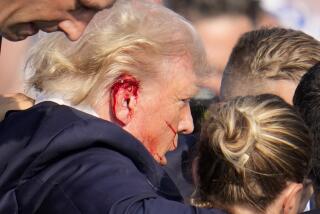Head trauma is not a death sentence
- Share via
A surprising number of patients who suffer gunshot wounds and other trauma to the head survive, and many do well, neurosurgeons said Saturday.
“I have seen every foreign body in the world pass through the brain, and I never cease to be amazed that some seem to survive and do amazingly well,” said Dr. Ian Armstrong, a Cedars-Sinai Medical Center staff member who was a trauma neurosurgeon at Texas Medical Center in Houston at a time when it had the highest rate of penetrating head injuries in the country.
A bullet to the brain “for us is almost a [once every] weekend occurrence, and some of them survive,” said Dr. Rafael Quinonez, a trauma neurosurgeon at Providence Holy Cross Medical Center in Mission Hills.
The most crucial factor in a head injury is which part of the brain is hit. The worst area is the brain stem, which is critical to breathing and other bodily functions. A bullet that passes through the brain stem is typically immediately lethal.
The next most serious would be if the bullet passes through both hemispheres of the brain, striking the diencephalon, which connects the two regions and is critical to functions such as consciousness and awareness. That is usually also fatal.
Media reports indicate that Rep. Gabrielle Giffords (D-Ariz.) was responding to commands from her doctors after surgery Saturday. If the bullet had gone through the diencephalon, “she would not be following commands,” said Dr. Neil A. Martin, chair of neurosurgery at UCLA’s Ronald Reagan Medical Center. “That’s a very favorable finding.”
The bullet, according to the doctors treating her, passed through her head and back out. Experts said that was fortunate because surgeons didn’t have to dig the bullet out and it didn’t break into smaller pieces that could have done more damage.
Martin noted that damage to parts of the brain called “eloquent areas” can cause significant neurological deficits, such as speech problems and difficulty moving arms or legs.
Former White House Press Secretary James Brady, for example, suffered such damage when he was shot in the head during the assassination attempt on President Reagan. In Giffords’ case, if those regions were spared, she could have a significant recovery.
Quinonez noted that a couple of years ago he treated a Palmdale carpenter who accidentally embedded six nails in his brain with a nail gun. He had a successful recovery because the eloquent areas were spared.
Assuming the damage to the congresswoman’s brain is minimal, Martin said, there are still many potential complications her physicians will have to watch for, such as infection and brain swelling.
Surgeons might, for example, have to remove bone to allow the brain to enlarge a bit if swelling occurs.
Vasospasm, a reaction of the blood vessels in the brain to the shock wave of the bullet and the subsequent bleeding, which typically occurs days later, can lead to a stroke.
Also, any injury to the brain could result in a seizure, Martin said, so doctors will need to put Giffords on preventative medication. “Her future looks reasonably promising, but there is a lot to watch for over the next week.”
Times staff writers Lisa Girion and Shari Roan contributed to this report.






